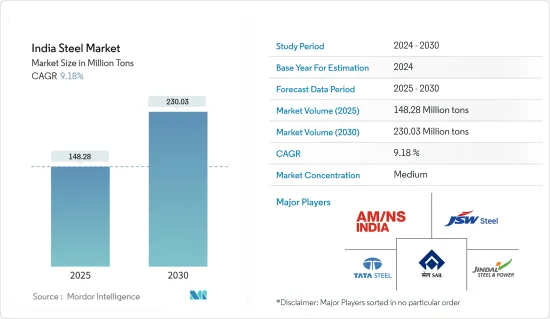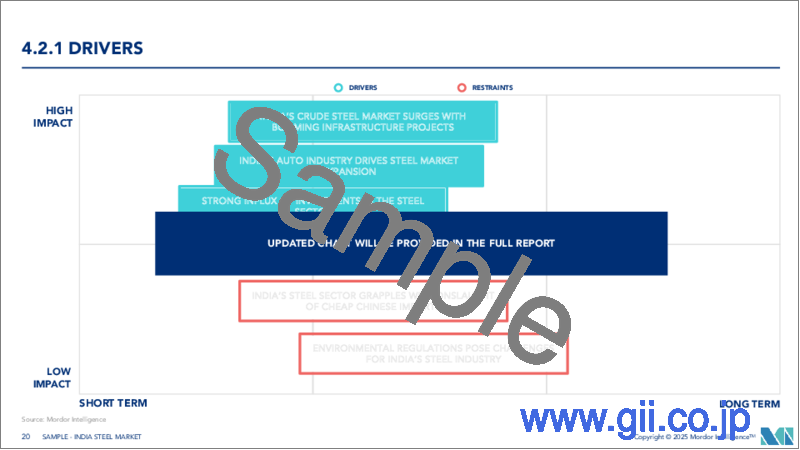|
|
市場調査レポート
商品コード
1693723
インドの鉄鋼- 市場シェア分析、産業動向と統計、成長予測(2025年~2030年)India Steel - Market Share Analysis, Industry Trends & Statistics, Growth Forecasts (2025 - 2030) |
||||||
カスタマイズ可能
適宜更新あり
|
|||||||
| インドの鉄鋼- 市場シェア分析、産業動向と統計、成長予測(2025年~2030年) |
|
出版日: 2025年03月18日
発行: Mordor Intelligence
ページ情報: 英文 120 Pages
納期: 2~3営業日
|
全表示
- 概要
- 目次
概要
インドの鉄鋼市場規模は2025年に1億4,828万トンと推定され、予測期間(2025~2030年)のCAGRは9.18%で、2030年には2億3,003万トンに達すると予測されます。

主要ハイライト
- インドでは自動車・輸送、建築・建設、その他を含む全産業の鉄鋼消費がCOVID-19の流行により制限されました。しかし、インドの鉄鋼市場は、ウイルスの蔓延を抑えるためにエンドユーザー産業が円滑に機能することで、力強い回復を示しました。現在、鉄鋼市場はパンデミックから回復し、大きく拡大しています。
- 短期的には、インド政府による強力な施策支援、鉄鋼セクタへの旺盛な投資流入、都市化の進展、建設インフラプロジェクトへの支出増加が、予測期間中の市場を牽引すると予測されます。
- しかし、一人当たりの鉄鋼消費量が少なく、生産コストが高いため、インドの鉄鋼メーカーの利益率は大幅に低下しました。価格変動は輸入業者に莫大な損失をもたらし、インドの鉄鋼市場の成長を阻害しました。
- 鉄鋼製造において炭素の代わりに水素を使用し、将来的には貿易や投資の機会が増えることが予想されるため、調査対象市場は予測期間中に有利な成長を遂げる可能性が高いです。
インドの鉄鋼市場動向
高炉-基礎酸素炉(BF-BOF)技術が市場を独占する
- BF-BOFルートは2段階プロセスです。製鉄:製鉄:鉄鉱石、コークス、石灰石を高炉に装入します。鉄鉱石を製錬して溶けた銑鉄を生産します。次に、製鋼です。溶融銑鉄は塩基性酸素炉(BOF)に装入されます。石炭は、製鉄のための主要な炭素含有物質として使用されます。鉄鉱石を精錬し、液体鉄に変えるのに必要な高温を発生させています。この液体鉄は転炉に入り、溶けた鉄に酸素を吹き込んで炭素やその他の不純物を除去します。
- こうしてできた鋼はインゴットやスラブに鋳造され、いくつかの圧延プロセスを経て棒鋼、線材、平鋼帯などの長尺製品に加工されます。鋼の特性や機能を高めるため、必要に応じて焼き戻しやコーティングも行われます。
- 高炉は、1日に最大1万トンの溶銑を生産することができます。、高炉は1回の加熱で最大300トンの鋼を生産することができます。
- 塩基性酸素炉(BOF)は、インドにおける粗鋼生産の最も好ましいプロセスルートでした。同国の鉄鋼生産量の90%以上を占めています。2022年末時点で、BOF技術は生産量の46%を占めています。
- インドでは、鉄鋼の68%が高炉ルートで製造されており、原料炭が主要な還元剤です。同時に、微粉炭注入(PCI)や天然ガスを補助還元剤として使用することもできます。BF-BOFルートでは、PCIに代わるグリーン水素が開発中です。
- インドの鉄鋼省によると、2022年末時点のインドにおける粗鋼生産はBOFが最も好ましいプロセスルートであり、約5,743万トン(粗鋼全体の46%)が生産され、2021年より8.35%増加しました。
- 予測期間中、ほとんどのBOFプラントはインドで設置されます。例えば、Tata Steel BSL Ltd.は、2024年度までにオディシャ州のMeramandali工場で607万トンのBOF能力を、Kalinganagar工場で300万トンのBOF能力を追加する計画です。さらに、インドにはさらに5,000万トンの潜在的なグロス生産能力があります。
- したがって、インドにおける高炉-基礎酸素炉(BF-BOF)技術の成長動向を考慮すると、BF-BOF技術が市場を独占する可能性が高いです。その結果、予測期間中に鉄鋼需要が拡大すると予想されます。
市場を独占する建築・建設産業
- 鉄鋼は鉄系金属に分類される人工合金です。鉄(地球上に自然に存在する金属元素)、炭素、その他の成分を含みます。建設は、その高い耐久性と強度により、鋼鉄を使用した構造物が作られるため、鋼鉄が広く使用されているセグメントです。鉄骨構造物は自然災害にも耐えることができ、特定のプロジェクトのニーズに合わせることもできます。
- 屋根材、母屋、内壁、天井、被覆材、外壁用断熱パネルなどの製品は、鋼鉄製です。また、冷暖房設備や屋内ダクトなど、建築物の非構造用途の多くにもスチールが使われています。
- 住宅から駐車場、学校、超高層ビルまで、あらゆる建築物は強度の面でスチールに依存しています。また、屋根や外壁の被覆材にもスチールが使われています。手すりや棚、階段などの内部設備もスチール製です。鉄骨は建物に頑丈で剛性のある骨組みを記載しています。
- 国家投資促進・円滑化庁によると、2022~23年のGDPに占める建築・建設産業の割合は約9%です。5,100万人近くがこの産業に従事しています。また、住宅・非住宅部門の増加により、2025年には1兆4,000億米ドルに達すると予想されています。
- インド工業連盟(CII)によると、国内の住宅建設は2022年に旺盛な需要を目の当たりにし、上位7都市(デリーNCR、バンガロール、ハイデラバード、ムンバイ、プネー、チェンナイ、コルカタ)がその牽引役となりました。約40万2,000戸の新築住宅が追加され、2021年比で44%増加しました。2023年第1四半期(Q1)の上位7都市の住宅販売戸数は11万4,000戸で、2022年比で9万9,500戸以上増加しました。
- 万人向け住宅を促進するプラダン・マントリ・アワス・ヨジュナ、サルダール・パテル都市住宅プロジェクト、100のスマートシティ・ミッション、中・小規模都市のインフラ建設など、政府の社会セクタプログラムがインドの鉄鋼業の成長を促進しています。
- インド政府は経済成長を後押しするため、インフラ整備に力を入れています。2022年から23年にかけて、政府は新しい道路や橋のインフラ整備に約6,457億3,000万インドルピー(77億7,356万米ドル)を割り当てました。同省は、セントラル・ビスタプロジェクトの下で非住宅用オフィスビルを建設するために260億インドルピー(3億1,300万米ドル)を発行しました。さらに、国家インフラパイプライン(NIP)では、108兆インドルピー(1兆3,000億米ドル)相当のインフラプロジェクトがさまざまな実施段階にあります。
- したがって、インドにおける建築・建設の成長動向を考慮すると、建築・建設産業が市場を独占する可能性が高いです。その結果、予測期間中に鉄鋼の需要が高まると予想されます。
インドの鉄鋼産業概要
インドの鉄鋼市場は部分的にセグメント化されています。主要企業(順不同)には、JSW STEEL LIMITED、TATA STEEL、Steel Authority of India Limited(SAIL)、AM/NS INDIA、JINDAL STEEL & POWER LIMITEDなどがあります。
その他の特典
- エクセル形式の市場予測(ME)シート
- 3ヶ月間のアナリストサポート
目次
第1章 イントロダクション
- 調査の前提条件
- 調査範囲
第2章 調査手法
第3章 エグゼクティブサマリー
第4章 市場力学
- 促進要因
- インド政府による強力な施策支援
- 鉄鋼セクタへの旺盛な投資
- 都市化の進展と建設インフラプロジェクトへの支出増加
- 抑制要因
- 一人当たりの鉄鋼消費量の少なさ
- 高い生産コスト
- 産業バリューチェーン分析
- ポーターのファイブフォース分析
- 供給企業の交渉力
- 買い手の交渉力
- 新規参入業者の脅威
- 代替品の脅威
- 競合の程度
第5章 市場セグメンテーション
- 基本形態
- 粗鋼
- 最終形態
- 完成鋼
- 製造技術
- 高炉-塩基性酸素炉(BF-BOF)
- 電気アーク炉(EAF)
- その他
- エンドユーザー産業
- 自動車と輸送
- 建築・建設
- 工具・機械
- エネルギー
- 消費財
- その他のエンドユーザー産業(石油・ガス抽出装置、家具、パイプ、バレル、ドラム、包装、半導体)
第6章 競合情勢
- 合併、買収、合弁事業、提携、協定
- 市場シェア分析
- 主要企業の戦略
- 企業プロファイル
- AM/NS India
- Jindal Stainless LIMITED
- JINDAL STEEL & POWER LIMITED
- JSW STEEL LIMITED
- NMDC Steel Limited
- RASHTRIYA ISPAT NIGAM LIMITED
- Steel Authority of India Limited(SAIL)
- TATA STEEL
- Vedanta Limited
第7章 市場機会と今後の動向
- 成長するサーキュラー・エコノミーの動向
目次
Product Code: 93661
The India Steel Market size is estimated at 148.28 million tons in 2025, and is expected to reach 230.03 million tons by 2030, at a CAGR of 9.18% during the forecast period (2025-2030).

Key Highlights
- Steel consumption across industries in India, including automotive and transportation, building and construction, and others, was restricted owing to the COVID-19 pandemic. However, the Indian steel market witnessed a strong recovery with the smooth functioning of the end-user industries in curbing the spread of the virus. Currently, the steel market recovered from the pandemic and is expanding significantly.
- Over the short term, strong policy support by the Indian Government, the strong influx of investments in the steel sector, increasing urbanization, and increased spending on construction and infrastructure projects are projected to drive the market during the forecast period.
- However, due to low per capita steel consumption and high production costs, the profit margin significantly decreased for steel manufacturers in India. The price fluctuation caused huge losses to importers, which hampered the growth of the Indian steel market.
- Nevertheless, using hydrogen instead of carbon in steel manufacturing and increasing trade and investment opportunities in the future for the market studied are likely to create lucrative growth over the forecast period.
India Steel Market Trends
Blast Furnace-Basic Oxygen Furnace (BF-BOF) Technology to Dominate the Market
- The BF-BOF route is a two-stage process: Ironmaking: Iron ore, coke, and limestone are charged into a blast furnace. The iron ore is smelted to produce molten pig iron. Second, it is Steelmaking: Molten pig iron is charged into a basic oxygen furnace (BOF). Coal is used as the primary carbon-bearing material for steelmaking. It generates high temperatures necessary to smelt the iron ore and convert it into liquid iron. This liquid iron enters the converter, where oxygen is blown through the molten iron to remove carbon and other impurities.
- The resulting steel is cast into ingots or slabs and processed into long products like bars, wire, or flat steel strips in several rolling operations. To enhance the characteristics and functions of steel, tempering or coating applications are also done when required.
- Blast furnaces can produce up to 10,000 tons of molten pig iron daily. Then, BOFs can produce up to 300 tons of steel per heat.
- A basic oxygen furnace (BOF) was the most preferred process route for the production of crude steel in India. It accounts for over 90% of the country's steel output. At the end of 2022, BOF technology accounted for 46% of the production.
- In India, 68% of steel is made through the Blast Furnace route in which coking coal is the primary reductant. At the same time, Pulverised Coal Injection (PCI) or Natural Gas can be used as an auxiliary reductant. Green Hydrogen to replace PCI in the BF-BOF route is under development.
- According to the Ministry of Steel of India, BOF was the most preferred process route to produce crude steel in India at the end of 2022, with around 57.43 million tons (46% of total crude steel) produced, which was 8.35% higher than in 2021.
- Most BOF plant installations will occur in India in the forecast period. For instance, Tata Steel BSL Ltd. plans to add 6.07 MMT of BOF capacity at the Meramandali works and 3.0 MMT of BOF capacity at the Kalinganagar works in Odisha state by FY 2024. Moreover, India holds an additional 50.0 MMT potential gross capacity.
- Therefore, considering the growth trends of blast furnace-basic oxygen furnace (BF-BOF) technology in India, the BF-BOF technology is likely to dominate the market. It, in turn, is expected to enhance the demand for steel during the forecast period.
Building and Construction Industry to Dominate the Market
- Steel is a man-made alloy that falls within the ferrous metal classification. It contains iron (a naturally occurring metal element on earth), carbon, and other components. Construction is a sector where steel is widely used since structures are created using it due to its high durability and strength. Steel structures can also withstand natural calamities and be tailored to the needs of a specific project.
- Products, such as roofing, purlins, internal walls, ceilings, cladding, and insulating panels for exterior walls, are made of steel. Steel is also found in many non-structural applications in buildings, such as heating and cooling equipment and interior ducting.
- Buildings from houses to car parks, schools, and skyscrapers all rely on steel for strength. Steel is also used on roofs and as cladding for exterior walls. Internal fixtures and fittings, such as rails, shelving, and stairs, are also made of steel. It provides a robust and stiff frame to the building.
- According to the National Investment Promotion and Facilitation Agency, the building and construction industry accounted for nearly 9% of the GDP in FY 2022-23. Nearly 51 million people are employed in the industry. Moreover, The industry is expected to reach USD 1.4 trillion by 2025 owing to rising residential and non-residential sectors in the country.
- According to the Confederation of Indian Industry (CII), housing construction in the country witnessed strong demand in 2022, with the top seven cities (Delhi NCR, Bangalore, Hyderabad, Mumbai, Pune, Chennai, and Kolkata). It added around 402 thousand units of new home construction, which was 44% higher than in 2021. In the first quarter (Q1) of 2023, housing sales in the top seven cities stood at 1.14 lakh units, an increase of over 99,500 units compared to 2022.
- Government social sector programs such as the Pradhan Mantri Awas Yojna, which promotes housing for all, the Sardar Patel Urban Housing Project, the 100 Smart Cities Mission, and the construction of infrastructure in medium and small towns are promoting the growth of the Indian steel industry.
- The Government of India strongly focuses on infrastructure development to boost economic growth. In 2022-23, the government allocated around INR 64,573 crore (USD 7,773.56 Million) for developing new roads and bridge infrastructure. The ministry issued INR 2,600 crore (USD 313 Million) to construct non-residential office buildings under the Central Vista Project. Moreover, under the National Infrastructure Pipeline (NIP), infrastructure projects worth INR 108 trillion (USD 1.3 trillion) are at different stages of implementation.
- Therefore, considering the growth trends of building and construction in India, the building and construction industry is likely to dominate the market. It, in turn, is expected to enhance the demand for steel during the forecast period.
India Steel Industry Overview
The Indian steel market is partially fragmented in nature. The major players (not in any particular order) include JSW STEEL LIMITED, TATA STEEL, Steel Authority of India Limited (SAIL), AM/NS INDIA, and JINDAL STEEL & POWER LIMITED, among others.
Additional Benefits:
- The market estimate (ME) sheet in Excel format
- 3 months of analyst support
TABLE OF CONTENTS
1 INTRODUCTION
- 1.1 Study Assumptions
- 1.2 Scope of the Study
2 RESEARCH METHODOLOGY
3 EXECUTIVE SUMMARY
4 MARKET DYNAMICS
- 4.1 Drivers
- 4.1.1 Strong Policy Support by the Indian Government
- 4.1.2 Strong Influx of Investments in the Steel Sector
- 4.1.3 Increasing Urbanization and Increased Spending on Construction and Infrastructure Projects
- 4.2 Restraints
- 4.2.1 Low Percapita Steel Consumption
- 4.2.2 High Production Costs
- 4.3 Industry Value-Chain Analysis
- 4.4 Porter's Five Forces Analysis
- 4.4.1 Bargaining Power of Suppliers
- 4.4.2 Bargaining Power of Buyers
- 4.4.3 Threat of New Entrants
- 4.4.4 Threat of Substitute Products and Services
- 4.4.5 Degree of Competition
5 MARKET SEGMENTATION (Market Size in Volume)
- 5.1 Basic Form
- 5.1.1 Crude Steel
- 5.2 Final Form
- 5.2.1 Finished Steel
- 5.3 Technology
- 5.3.1 Blast Furnace-basic Oxygen Furnace (BF-BOF)
- 5.3.2 Electric Arc Furnace (EAF)
- 5.3.3 Other Technologies
- 5.4 End User Industry
- 5.4.1 Automotive and Transportation
- 5.4.2 Building and Construction
- 5.4.3 Tools and Machinery
- 5.4.4 Energy
- 5.4.5 Consumer Goods
- 5.4.6 Other End-user Industries (Oil and Gas Extraction Equipment, Furniture, Pipes, Barrels, Drums, Packaging, Semiconductors)
6 COMPETITIVE LANDSCAPE
- 6.1 Mergers, Acquisitions, Joint Ventures, Collaborations, and Agreements
- 6.2 Market Share Analysis
- 6.3 Strategies Adopted by Leading Players
- 6.4 Company Profiles
- 6.4.1 AM/NS India
- 6.4.2 Jindal Stainless LIMITED
- 6.4.3 JINDAL STEEL & POWER LIMITED
- 6.4.4 JSW STEEL LIMITED
- 6.4.5 NMDC Steel Limited
- 6.4.6 RASHTRIYA ISPAT NIGAM LIMITED
- 6.4.7 Steel Authority of India Limited (SAIL)
- 6.4.8 TATA STEEL
- 6.4.9 Vedanta Limited
7 MARKET OPPORTUNITIES AND FUTURE TRENDS
- 7.1 Growing Trend of Circular Economy





